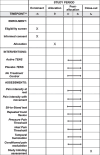Effects of transcutaneous electrical nerve stimulation on pain, function, and descending inhibition in people with non-specific chronic low-back pain: a study protocol for a randomized crossover trial
- PMID: 38582874
- PMCID: PMC10998305
- DOI: 10.1186/s13063-024-08089-7
Effects of transcutaneous electrical nerve stimulation on pain, function, and descending inhibition in people with non-specific chronic low-back pain: a study protocol for a randomized crossover trial
Abstract
Background: Low back pain (LBP) is a significant public health problem, is very prevalent, and is often characterized by the persistence of symptoms. Transcutaneous electrical nerve stimulation (TENS) may benefit people with chronic LBP because it can activate descending inhibitory pathways and inhibit central excitability. However, previous studies that have investigated the effects of TENS on pain in people with LBP have failed to use proper intensities of current, and the timing of the assessment of pain was not performed during the peak of the analgesic response or functional activities. Therefore, the present study aims to assess the effects of TENS on measures of pain, function, and descending inhibition using the maximal tolerable intensity of TENS in participants with LBP.
Methods/design: This study will be a randomized crossover trial. The participants for this study will be recruited from various places, including the University of Hartford, physical therapy clinics, and local businesses in the Hartford area, as well as online websites geared towards clinical trial recruitment. A total of 34 participants will receive all three treatments: active TENS, placebo TENS, and no treatment control. The treatment order will be randomized using a website-based randomization tool. For active TENS, a modulating frequency of 2-125 Hz will be applied with a variable pulse duration and maximal tolerable intensity for 30 min. The TENS will be left on for post-treatment testing to assess the effects during its maximally effective period for a total of 50 to 60 min. Furthermore, the intensity may be turned down if muscle twitching is present to ensure blinding of the evaluator. For placebo TENS, the unit will deliver current for 45 s, ramping to 0 in the last 15 s. The primary outcome will be pain intensity at rest and with movement, determined using the numerical pain rating scale. The secondary outcomes will be pressure pain threshold, heat pain threshold, temporal summation of pain, conditioned pain modulation, sit-to-stand test, and repeated trunk flexion. The assessments will be performed immediately before and after treatment. Statistical analysis of the data obtained will consider a significance level of p < 0.05.
Discussion: This study will provide evidence concerning the effects and mechanisms of TENS treatment in participants with chronic non-specific low back pain. The outcomes, including pain, function, and descending inhibition, will help us gain a greater understanding of how TENS can be used for these participants.
Trial registration: ClinicalTrials.gov NCT05812885. Registered on 24th May 2023.
Keywords: Analgesics; Low back pain; Nociception; Pain measurement; Pain threshold; Randomized controlled trial; Study protocol; Transcutaneous electric nerve stimulation.
© 2024. The Author(s).
Conflict of interest statement
The authors declare that they have no competing interests.
Figures
References
-
- Zaina F, Cote P, Cancelliere C, Di Felice F, Donzelli S, Rauch A, et al. A systematic review of clinical practice guidelines for persons with non-specific low back pain with and without radiculopathy: identification of best evidence for rehabilitation to develop the WHO's Package of Interventions for Rehabilitation. Arch Phys Med Rehabil. 2023;104(11):1913–1927. doi: 10.1016/j.apmr.2023.02.022. - DOI - PubMed
-
- Jensen OK, Nielsen CV, Stengaard-Pedersen K. Diffuse central sensitization in low back patients: a secondary analysis of cross-sectional data including tender point examination and magnetic resonance imaging of the lumbar spine. Medicine (Baltimore) 2020;99(38):e22198. doi: 10.1097/MD.0000000000022198. - DOI - PMC - PubMed
Publication types
MeSH terms
Associated data
Grants and funding
LinkOut - more resources
Full Text Sources
Medical
Miscellaneous


